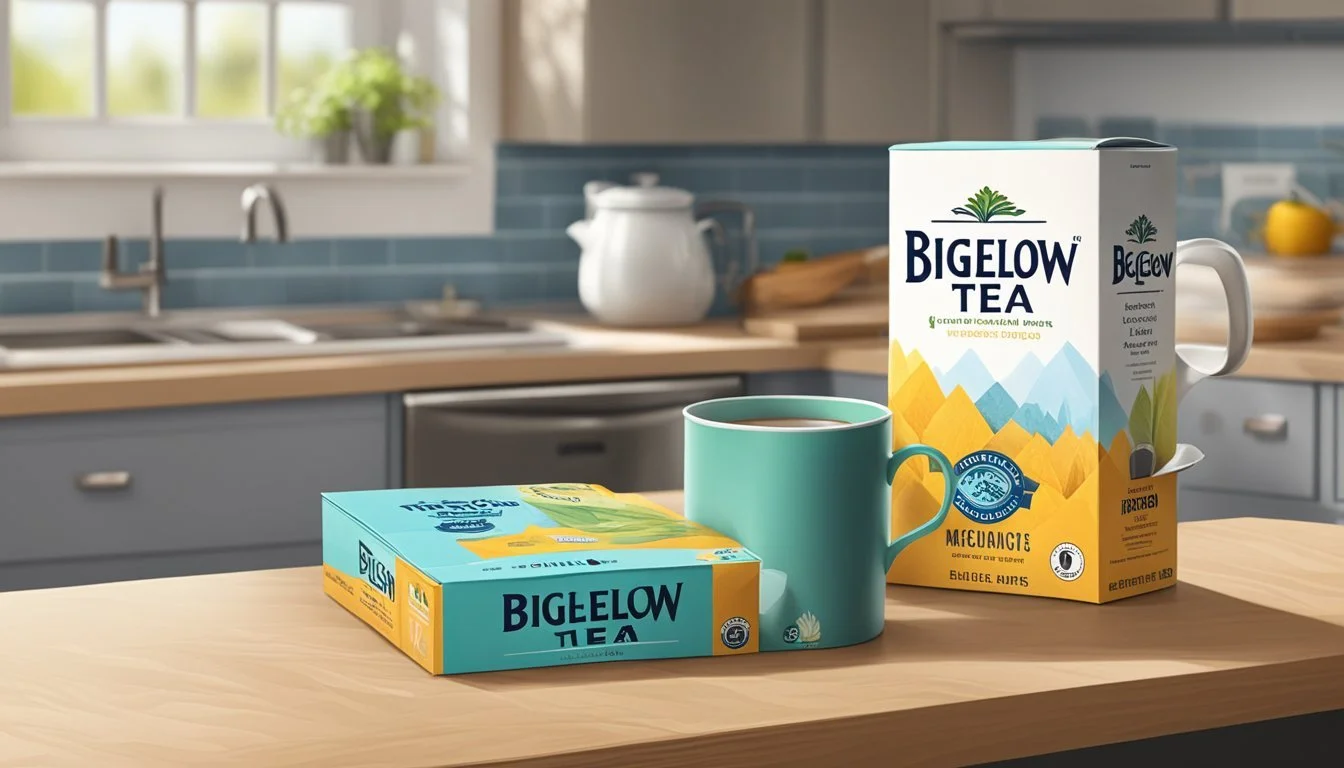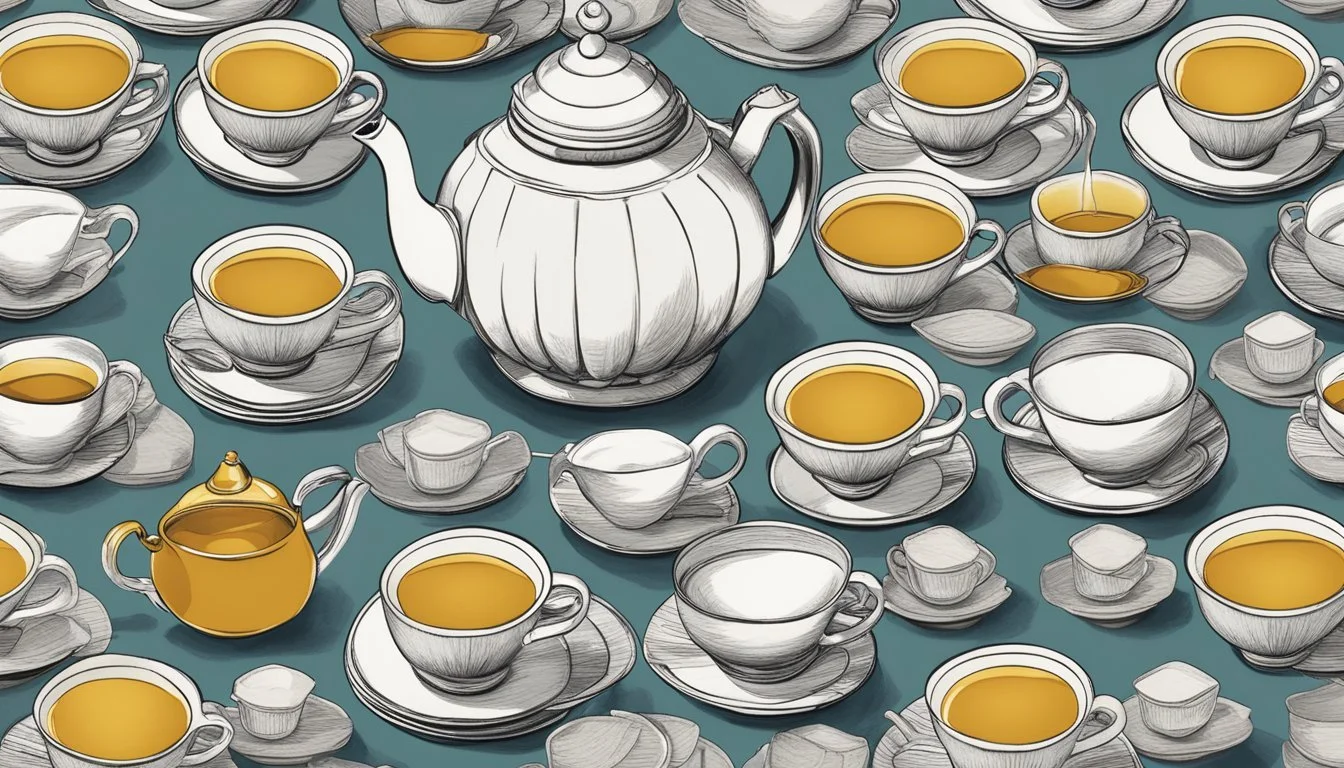How Many Cups of Bigelow Tea Per Day Is Too Much?
Understanding Safe Consumption Limits
Bigelow Tea, a staple in American households, offers a range of aromatic blends that invite contemplation on the ideal daily consumption. Given its caffeine content and the comforting experience it provides, tea enthusiasts often question the limits of their daily intake. While individual tolerance levels can vary, it is widely considered that moderate consumption of tea fits well within a healthy lifestyle.
The debate on how many cups of tea per day is optimal is not just a matter of preference but also of health considerations. Research suggests that moderate amounts of tea can offer health benefits, which for some may imply one cup a day, while for others, up to five cups may be beneficial. Identifying the threshold beyond which tea consumption might become excessive depends on several factors, including caffeine sensitivity and the specific tea variety.
In the case of Bigelow Tea, as with any tea, recommended steeping times and frequency of consumption are crucial to maximizing benefits while minimizing potential adverse effects such as sleep disturbances or heightened anxiety due to excessive caffeine intake. Each blend comes with steeping recommendations to ensure the right balance of flavor and potency, which, when adhered to, contributes to the enjoyment and healthfulness of the beverage.
Understanding the Basics of Tea
When exploring the consumption of Bigelow tea, one must understand the various types of tea and their respective caffeine content. This will inform decisions about how much tea one can enjoy daily without consuming too much caffeine.
Types of Tea
Camellia sinensis is the plant responsible for various tea types, including black tea, green tea, oolong, and white tea. Their differences arise from the processing methods after harvesting. Black tea is fully oxidized, offering a robust flavor, green tea remains unoxidized, keeping a more delicate taste and higher levels of antioxidants, oolong tea is partially oxidized, and white tea is the least processed, known for its subtlety and natural sweetness.
Black Tea: Robust flavor, fully oxidized.
Green Tea: Delicate flavor, rich in antioxidants, unoxidized.
Oolong Tea: Partially oxidized, a balance of black and green tea flavors.
White Tea: Subtle and sweet, least processed.
Herbal tea is not technically a tea as it does not come from Camellia sinensis. It is an infusion of various herbs, spices, and other plant materials, which typically does not contain caffeine unless mixed with true tea leaves.
Caffeine in Tea
The caffeine content in tea can vary widely depending on the type:
Black Tea: Approximately 40-70 mg of caffeine per 8 oz.
Green Tea: Roughly 20-45 mg of caffeine per 8 oz.
Oolong Tea: Between 30-50 mg of caffeine per 8 oz.
White Tea: Around 15-30 mg of caffeine per 8 oz.
Herbal Tea: Generally caffeine-free, unless blended with caffeinated tea leaves.
Decaffeinated teas are available in various types and typically contain less than 2-5 mg of caffeine per 8 oz. It's important to note that the longer tea steeps, the more caffeine it will likely release into the cup.
In summary, tea offers a variety of choices for those monitoring their caffeine intake, with decaffeinated options offering a minimal caffeine alternative while still enjoying the benefits and tastes of tea.
Health Benefits and Risks
Consuming Bigelow green tea in moderation can offer numerous health benefits due to its rich content of antioxidants and nutrients. However, it's crucial to be aware of the potential risks and side effects associated with excessive consumption.
Positive Effects on Health
Antioxidants and Heart Health: Green tea is abundant in polyphenols like catechins, including EGCG (epigallocatechin gallate), which are potent antioxidants. They play a significant role in reducing inflammation and have been linked to a lower risk of heart disease. The catechins in green tea can also aid in improving heart and blood pressure conditions.
Cancer Prevention: Studies suggest that the antioxidants in green tea may lower the risk of various cancers, such as breast and oral cancer.
Weight Loss and Metabolism: Regular consumption can boost the metabolic rate in the short term, potentially aiding in weight loss.
Brain Function: Catechins may have neuroprotective properties, contributing to improved cognitive function.
Diabetes and Blood Sugar Levels: Green tea can aid in managing blood sugar levels, thus offering potential benefits for individuals with diabetes.
Oral Health: The catechins have been shown to kill bacteria and inhibit viruses like the influenza virus, potentially reducing the risk of infections and improving oral health.
Potential Risks and Side Effects
Iron Absorption and Anemia: The catechins in green tea can interfere with iron absorption, potentially leading to or exacerbating anemia, especially in individuals with existing iron deficiency.
Interactions with Medications: Green tea might interact adversely with certain medications, including heart and blood pressure medications.
Sleep Disruptions: Despite the calming effects of L-theanine, the caffeine content could disturb sleep patterns if consumed later in the day.
Nutrition and Overconsumption: Excessive green tea intake may lead to nutritional imbalances or overload the body with too much EGCG, which could be harmful in high amounts. It's generally recommended to limit intake to 2-3 cups per day to avoid negative effects on health.
Tea Consumption Guidelines
When determining how much Bigelow tea to drink per day, one must consider both general recommendations and specific needs of different populations. The amount can vary based on individual lifestyle, health conditions, and personal preferences regarding additions like sugar, honey, and lemon.
General Recommendations
For the average adult, consuming around 2 to 4 cups of Bigelow tea daily is commonly deemed appropriate. This aligns with the caffeine content found in black teas, which is typically 30-60 mg per 8 fl oz serving. In comparison, coffee contains about 100-120 mg per serving. Regular consumption of tea can be a part of a healthy lifestyle, potentially improving mood due to the presence of L-theanine, which has been linked to mood enhancement and stress reduction.
Sugar and Sweeteners: Adding sugar or sweeteners can increase calorie intake. Options like honey can also be used, which might offer antibacterial benefits.
Lemon: Incorporating lemon not only adds flavor but may also aid in iron absorption.
Caffeine: Individuals sensitive to caffeine should monitor their consumption, particularly later in the day, to avoid disrupting normal sleep patterns.
Special Considerations for Different Populations
Certain populations need to take extra care with tea intake:
Pregnant Women: It is typically advised that pregnant women limit their caffeine consumption to less than 200 mg per day. They should consult healthcare providers to determine the right amount as it can affect iron absorption and could interact with supplements or medications.
Nursing Mothers: Similar to pregnant women, nursing mothers should moderate caffeine intake to prevent it from affecting the baby.
Individuals on Medications: Tea can interact with certain medications and supplements, potentially affecting efficacy and leading to bleeding or other adverse effects. Consulting a healthcare professional is key.
It's important for individuals to consider their own health conditions and dietary needs when deciding how much tea to consume. A nutrient-rich diet with an active lifestyle significantly contributes to the health benefits of tea consumption.
Flavors and Additives in Tea
When selecting a tea, consumers often encounter a variety of flavors and additives that can alter the taste, aroma, and nutritional profile of the beverage. Understanding these ingredients is crucial for determining the overall impact on health and enjoyment of tea drinking.
Natural and Artificial Flavors
Teas come in an array of flavors, ranging from traditional options like chamomile and mint to more innovative blends such as blackberry citrus plus zinc herbal tea. Natural flavors, derived from plants, seeds, or fruits, including pomegranate and lavender, contribute to the complexity and desired taste profiles of the tea. For instance, chamomile tea is known for its calming properties, while mint offers a refreshing zest.
In contrast, artificial flavors are synthesized to mimic natural tastes. While these may provide a consistent flavor experience, they do not offer the same nutritional benefits as their natural counterparts. It is essential for consumers to check labels to understand which type of flavors are present in their tea.
Sweeteners and Their Impact
Sweeteners in tea can greatly influence both the taste and healthfulness of the beverage. Natural sweeteners like stevia are plant-based alternatives to sugar, offering sweetness without added calories. They are often present in flavored teas to enhance taste without the health drawbacks associated with sugar.
Conversely, artificial sweeteners, used to reduce calorie content while maintaining sweetness, may be included in diet or reduced-calorie tea products. The impact of artificial sweeteners on health is a topic of ongoing research, and their effects may vary among individuals.
Among flavored teas, certain varieties like chocolate or blackberry citrus often incorporate sweeteners to balance the natural tartness or bitterness of the primary flavors. The use of sweeteners should be moderated as excessive consumption may counteract some of the health benefits of tea drinking.
Consumers should scrutinize product labels for specific sweetener content to make informed choices that align with their dietary preferences and restrictions.
Brewing and Preparation of Tea
Before diving into the specific methods, it’s crucial to understand the right brewing techniques to maximize the taste and benefits of tea.
The Brewing Process
The process of brewing tea can be both an art and a science. To begin, one must heat water to the appropriate temperature, which varies depending on the type of tea. Black and herbal teas typically require boiling water, while green tea is better steeped with water just short of boiling to avoid bitterness. For Bigelow tea products, the packaging indicates the optimal steeping time which is usually between 2 to 4 minutes for black teas and up to 4 minutes for herbal teas. The act of steeping allows the flavors and compounds within the Camellia sinensis leaves or the herbal blend to infuse into the water, creating a pleasing aroma and flavor profile.
Optimal Water Temperatures:
Black Tea: 100°C (Boiling)
Green Tea: 80–85°C
Herbal Tea: 100°C (Boiling)
Steeping Times:
Black Tea: 2-4 minutes
Herbal Tea: 4 minutes
Green Tea: 1-3 minutes
Covering the cup or teapot during steeping helps to trap heat and ensures a consistent infusion.
Tea Bag Versus Loose Leaf
Tea bags offer convenience and consistency, with pre-measured portions of tea leaves typically enclosed in paper, silk, or nylon. A single tea bag is ideal for one cup of water, around 236.85 mL (8 US fluid ounces). In contrast, loose leaf tea provides the opportunity for a more nuanced flavor, as the tea leaves have more room to expand and release their essence during the steeping process.
For those seeking quick preparation without compromising on quality, instant tea mixes and powdered forms like matcha are available. Matcha involves the grinding of the whole tea leaf into a fine powder, which is then whisked with water to produce a frothy, vibrant cup of tea that is rich in flavor and nutrients.
Using either tea bags or loose leaf options, the brewing process is key to unlocking the full potential of tea derived from the Camellia sinensis plant, or various herbal infusions. Whether one opts for the convenience of tea bags or the traditional approach of loose leaf tea, attention to detail in brewing and preparation is central to achieving the perfect cup of tea.
Regional Considerations for Tea Drinking
The amount of Bigelow tea that one can consume daily without adverse effects can vary significantly depending on regional dietary customs and genetic factors.
Tea Culture in Different Regions
Alaska (AK)
In Alaska, the cooler climate could influence residents to consume hot beverages such as tea more frequently throughout the day for warmth. However, access to fresh produce and goods can be limited in more isolated areas, potentially affecting tea availability and consumption habits.Hawaii (HI)
Hawaiians have access to a variety of local herbal teas unique to the region's abundant flora. The tradition of tea drinking in Hawaii may often include these local ingredients, with a potential for lower caffeine content compared to traditional black or green Bigelow teas.Puerto Rico (PR)
Residents of Puerto Rico enjoy a diverse array of cultural influences, including a Spanish heritage, which might affect their tea-drinking patterns. The tropical climate offers a wide range of local herbs and plants that can be used for making tea infusions, potentially decreasing the total amount of caffeinated tea consumed.
Tea and Its Intersection with Other Dietary Elements
When considering the daily intake of Bigelow tea, it is important to understand its interactions with other dietary elements. These interactions can influence the absorption of nutrients, the effects of medications, and even the overall enjoyment of foods and beverages.
Tea and Other Beverages
Tea contains compounds such as theanine, specifically L-theanine, which is known to promote relaxation and may enhance the quality of sleep. Coffee, a popular beverage alternative to tea, contains considerably more caffeine but lacks L-theanine. Combining coffee with tea could lead to an excessive intake of caffeine, potentially negating the calming properties of L-theanine.
Furthermore, the consumption of Bigelow tea alongside organic beverages that contain EGCG (Epigallocatechin gallate) could amplify the antioxidant benefits, as EGCG is a potent antioxidant found in tea. However, tea's antibacterial properties may reduce when consumed with certain beverages, depending on their composition.
Tea and Food Interactions
Tea can interact with food in various ways. For instance:
Iron Absorption: The tannins in tea can hinder the absorption of non-heme iron found in plant-based foods. It is recommended to avoid drinking tea during or immediately after a meal rich in iron.
Medications and Supplements: Tea can affect the body's ability to absorb certain medications and supplements. A noteworthy interaction is between tea and iron supplements, where tea is known to decrease the absorption of iron from supplements. It is advisable to maintain a gap between consuming tea and taking iron supplements to optimize iron uptake.
Food Interactions:
Food Type Interaction with Tea Note High-iron Foods Decreases Absorption Consume tea 1-2 hours before or after the meal Probiotic Foods Theoretical Benefit Increase Antibacterial properties may support gut health Calcium-rich Foods Potential Decrease May affect the absorption of calcium
In summary, while integrating Bigelow tea into one's diet, it is important to consider these factors for optimal health benefits and minimal negative interactions.
Environmental and Ethical Aspects of Tea Production
The environmental and ethical impact of tea production is significant, encompassing organic and conventional farming practices to sustainable packaging solutions.
Organic Versus Conventional Tea
Organic tea cultivation is a farming approach that avoids the use of synthetic fertilizers and pesticides, aiming to reduce the environmental footprint and potential health risks associated with chemical use. Conventional tea farming, however, relies on these synthetic inputs to increase yield but may contribute to soil degradation, biodiversity loss, and water contamination. Consumers prioritizing eco-friendly products often prefer organic tea for its perceived lower impact on the environment.
Sustainable Tea Farming and Packaging
Sustainable tea farming involves practices such as:
Water conservation, using methods like rainwater harvesting to mitigate water scarcity.
Energy efficiency, implementing processing techniques that lower carbon emissions.
Biodiversity protection, promoting varied ecosystems within tea plantations.
Sustainable packaging focuses on reducing waste through:
Utilizing biodegradable or recyclable materials.
Minimizing packaging or using designs that extend the life-cycle of the packaging.
Employing eco-friendly labeling methods that do not contribute to pollution.
Through these measures, tea producers aim to address the ethical demands of the market while conserving resources and minimizing environmental damage. Sustainable practices in both farming and packaging are essential contributors to the longevity and ethical responsibility of the tea industry.
Consumer Guide
When selecting Bigelow tea and understanding its consumption guidelines, consumers must consider personal preferences and health advisories. A well-informed choice ensures a balance between enjoyment and well-being.
How to Choose the Right Tea
Consumers should first identify their taste preference and desired benefits. For example, Bigelow offers a variety of flavors ranging from herbal to black teas. Herbal teas are typically caffeine-free and can be a good choice for evening consumption, while black teas are suited for a morning boost due to their caffeine content. The Caff-O-Meter on Bigelow packaging indicates the caffeine level, helping consumers make an informed choice based on their sensitivity or dietary restrictions.
Understanding Tea Labels and Claims
It’s essential for consumers to check the labels on tea packaging for steeping times and recommended intake. Bigelow provides steeping instructions, ensuring optimal flavor and efficacy. Here are some guidelines:
Tea Type Steep Time Herbal 4 minutes Black 2-4 minutes
When it comes to quantity, drinking 2-3 cups of Bigelow green tea per day is considered safe for most individuals. However, consumers must discover their personal limits, especially if they have caffeine sensitivities or specific health conditions. If purchasing in bulk, a case usually contains six boxes of a single tea type, which can be an economical choice for regular drinkers.
Frequently Asked Questions
When considering the consumption of Bigelow tea or any tea, readers should be attentive to the caffeine content and potential side effects. Proper knowledge can ensure safe daily intake and avoidance of adverse interactions with medications or health conditions.
Daily Intake and Limitations of Tea Consumption
Bigelow Tea, just like other teas, contains caffeine, which can impact mood and oral health. A moderate intake is typically safe for most individuals, and according to sources like EatingWell, drinking three to five cups of green tea per day is in the safe zone. It's essential to note that the caffeine content varies among different teas. Bigelow green tea, for instance, has about 25-50 milligrams of caffeine per 8-ounce serving.
Side effects: Excessive consumption may lead to jitteriness, headaches, or sleep disturbances due to the caffeine.
Anemia: Tea can inhibit iron absorption, so individuals with anemia should watch their tea intake.
Medication: Tea can interact with certain medications; therefore, consulting with healthcare providers is important.
Nursing: Nursing mothers should moderate caffeine intake to prevent its transfer to breast milk.
Oral health: Tea can positively affect oral health; however, it may also stain the teeth due to its tannin content.
It is always advised for individuals with specific health conditions or concerns (like anemia or those on medications) to seek guidance from a healthcare professional regarding the safe amount of tea for their personal consumption.
Conclusions
When considering the appropriate daily intake of Bigelow tea, or any brand for that matter, individuals should be aware of their own sensitivity to caffeine as well as any medical conditions they might have. A moderate consumption generally falls within the range of 3-4 cups a day. It is important to recognize that exceeding this may lead to negative side effects due to excessive caffeine intake.
Recommended Intake: 3-4 cups
Caffeine Content: Varies by tea type
Side Effects: Possible at high consumption levels
Specifically for green tea, studies suggest that 1-3 cups daily may lower the risk of heart conditions. This benefit stems from the relaxation of vascular cells and subsequent dilation of blood vessels. However, individuals with iron deficiencies should exercise caution due to tea's tannins, which can inhibit iron absorption.
Finally, the steeping time for tea crucially affects its potency and flavor. Bigelow Tea packaging offers specific recommendations:
Herbal Teas: 4 minutes
Black Teas: 2-4 minutes
Tea drinkers should avoid steeping tea for longer than the recommended time to prevent excessive extraction of caffeine and tannins.
In summary, tea consumers should tailor their Bigelow tea intake to individual health considerations and steeping times, staying within the recommended range to enjoy the benefits without encountering adverse effects.













